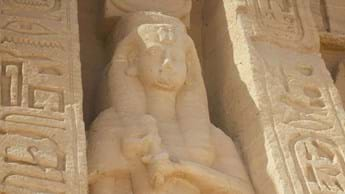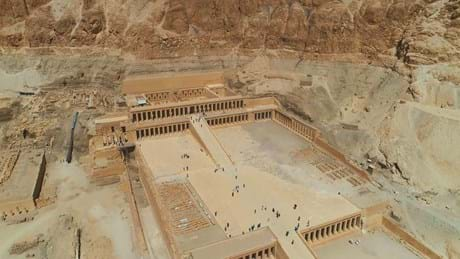Dr. Colleen Darnell Explores the Lost Treasures of Egypt
Egyptologist Dr. Colleen Darnell pieces together an image of women in power in Ancient Egypt

Egyptologist Dr. Colleen Darnell returns for a third season of Lost Treasures of Egypt, as she takes time off from the digging season to walk around the temple complexes and tombs at Deir el-Bahari, Luxor and Abu Simbel. She’ll help us to get up close and personal with artefacts, statues, structures and read us hieroglyphics to puzzle out how Ancient Egypt’s Queens rose to power and held onto it.
But with Egyptology, the more you know, the more questions you have. We had the good luck of being able to ask Colleen to expand a little more on episode 5, titled Secrets of Egypt’s Queens…
Watch Lost Treasures of Egypt now Watch National Geographic now Set a reminder
Watch Lost Treasures of Egypt Season 3, Fridays at 19:00 on National Geographic (DStv Channel 181)
The Opening Of The Mouth
When you were reading hieroglyphics about Nefatari and Hatshepsut in person this season, what were some of the details that caught your attention?
“Really fascinating to me, was going back to the mortuary temple of Deir el-Bahari and taking a detailed look at the image of Hatshepsut as a Sphinx. I knew it was there based on the original publication on Deir el-Bahari, which is almost 100 years old now. Seeing the Sphinx image in particular, that was really fun, because it was so damaged – intentionally – by Thutmose The Third at the end of his reign. It's difficult to make out the details in the drawing, so that was something exciting to see in person and being able to read some of her Divine Birth scene, which is such a fascinating piece of the puzzle of how ancient Egyptian kings viewed themselves. Seti is the first king to have this complete cycle of scenes, so she's tapping into something that has already existed for 600 or 700 years, and then she gets copied by later kings. It's remarkable how much she influences other kings of her dynasty. A lot of the same things were true with Nefatari with respect to queenship and it was really exciting filming at Abu Simbel and looking at where Nefatari accompanies Ramses The Second in his military activities and smiting scenes. I had always looked at the temple of Nefatari at Abu Simbel because of its religious connotations and the association of the queen with The Goddess Hathor, so looking at it from a military perspective was really fun.”
How would Hatshepsut have started off with portraying herself as pharaoh?
“It's fascinating to see her artistic transformation. At the very beginning of her reign as king – about seven years after the death of her husband Thutmose The Second – she was ruling not as a king, but rather as a queen, who is stepping in for Thutmose The Third, her nephew. But she is also – and this is 1 of the most important aspects of her role in ultimately becoming king – the chief Priestess of the Temple of Karnak, the chief priestess of Amun, or what they called the God’s Wife of Amun. Then at Deir el-Bahari, what we primarily see is the final phase of her artistic transformation, where she is showing herself entirely male, but in the hieroglyphic tags, from her name Hatshepsut, which means “She who is foremost of the noble ladies”, to anytime she's referred to, the vast majority of tags use feminine pronouns, as well as feminine versions of epithets. She's not the son of Ra, she's the daughter of Ra. And there are statues in the Metropolitan Museum of Art from Deir El-Bahari that show Hatshepsut in a more androgynous form, where she still has a slightly feminine body, but she's only wearing kilts, she doesn't have a dress on. Most of those were destroyed, because there really was no way to repurpose those statues, since they had such an unusual combination of features. There's so much we still don't know. That's why I like the episode title, Secrets of Egypt's Queens (episode 5) because there really are still secrets!”
Do the statues of Hatshepsut and Nefatari show ageing through their reigns?
“Compared to the portraits of Queen Elizabeth The Second, we actually do not see an ageing process in the imagery of Nefatari. She is just as young and slim in the temple of Abu Simbel as she is in her own tomb, and we have no reason to believe that she died particularly young. 1 of the few exceptions is actually during the reign of Akhenaton. There are portraits of Queen Nefertiti, where she is shown slightly older. We see a little bit more lines on her face, but that is the exception rather than the rule in ancient Egyptian art.”
What rights and powers would Hatshepsut and Nefatari have had at birth?
“Both of them had tremendous amounts of power when they were born, Hatshepsut as a member of the royal family already. The parentage of Nefatari is still somewhat questionable, but certainly she would have been elevated to the highest possible rank of any woman when she became the Great King's wife of Ramses The Second. Women in general in ancient Egyptian society had legal equality with men. They could own property, and they did not need a man to represent them in a court trial. Obviously, class made a tremendous amount of difference in how people experienced life in ancient Egypt. But among so many ancient cultures, the very fact that they have equality in the legal system is a lot and I think we have to take that seriously.”
How was Hatshepsut able to get her court to go along with her idea of being a pharaoh?
“That is a very interesting question for which we do not have a complete answer. What gave her that added advantage in becoming king was her role of the God’s Wife of Amun. It is that position that gave her religious authority, and also a lot of wealth. From the very beginning of the 18th dynasty, the God’s Wife of Amun had her own estates. So beyond being a queen, beyond being a member of the royal family, the daughter of a king, the wife and half-sister of Thutmose The Second, she also had her own estates, her own wealth. I think it was the knowledge and the religious authority that she possessed as God's Wife, that enabled her to do something that very few other queens could do. And to me, that's kind of the answer to the mystery to the secret of Hatshepsut’s power. I wish we had more records of what was going on in the court and whether there did end up ultimately being conflict between the courtiers who supported Thutmose The Third and the courtiers who supported Hatshepsut.”

Watch Lost Treasures of Egypt Season 3, Fridays at 19:00 on National Geographic (DStv Channel 181)
National Geographic (DStv Channel 181) is available exclusively on DStv Premium, Compact Plus, Compact and Family. To upgrade your existing package, click here. Or if you'd like to Get DStv, find a service that suits your needs here.



